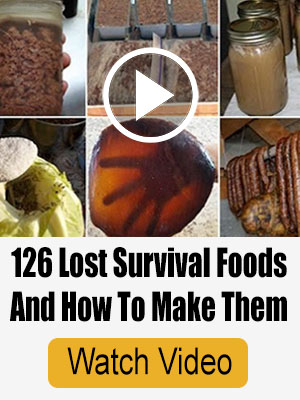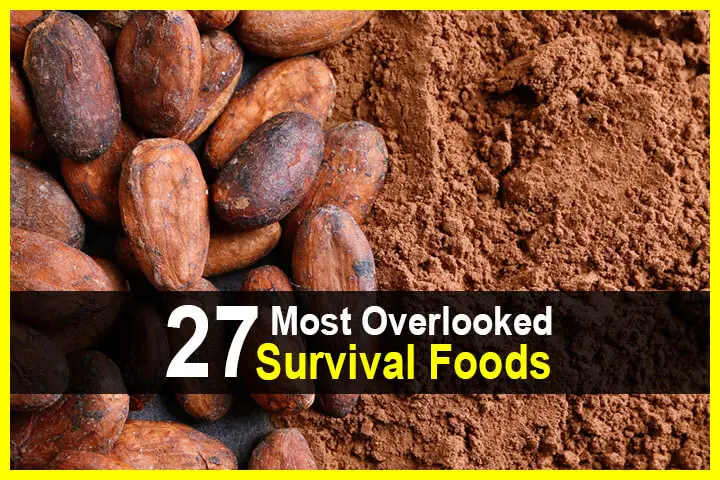Estimated reading time: 12 minutes
When you read about what to stockpile for an emergency, you tend to see the same recommendations. Water tops every list, and rightly so since water is essential for survival.
In terms of food, however, rice, beans, pasta, and canned vegetables show up frequently as staples to have on hand. Then, you usually see sugar, flour, and other long-lasting foods. These are good options, but many other choices are often overlooked.
Here is a list of foods and ingredients that offer a long shelf life as well as nutrition that you will need in an emergency scenario.
Want to save this post for later? Click Here to Pin It On Pinterest!
1. Bouillon Cubes
Bouillon cubes are more important than most people realize. They last indefinitely, they take up very little space, and they can make a pot of stew taste about ten times better, in my opinion.
2. Canned Coconut Milk
Canned coconut milk, with a shelf life of 2 to 5 years, is a great item to have in your emergency pantry. It’s not only a key ingredient in many Asian dishes but also serves as a dairy substitute for those with lactose intolerance. Rich in calories and healthy fats, it can provide the much-needed energy in a survival situation. Use it in cooking, baking, or even as a creamer in your emergency coffee supply.
3. Canned Pink Salmon
Canned pink salmon offers a shelf life of up to six years when stored unopened in a cool, dark pantry. The fish is filling and offers healthy omega-3 fatty acids in a high-quality protein form. A USDA study found that there were slightly higher levels of two omega-3 acids in canned pink salmon than there were in fresh salmon.
4. Cocoa Powder
Everybody takes chocolate for granted, but did you know that in the near future, it could become a rare delicacy? Chocolate consumption is increasing faster than cocoa production. Pretty soon, people might only get to enjoy chocolate during the holidays.
The good news is that cocoa powder can last for decades when stored properly. Although no one needs a cup of hot chocolate to survive the collapse of society, it certainly doesn’t hurt.
5. Coconut Oil
Coconut oil is solid at room temperature and is able to withstand high cooking temperatures (such as over a fire in a survival situation). It routinely has a shelf life of more than two years, and you can use it as a replacement for butter in baking and cooking.
Coconut oil also has many other purposes in an emergency scenario, including as a skin moisturizer, as a healing balm, and as a hair product.
6. Dehydrated Fruit
Offering a range of healthy vitamins and nutrients as well as calories, most dehydrated fruits will store well for up to five years. And there are plenty of options besides raisins and dates. Try dried cranberries, figs, dried cherries, dried apricots, banana chips, dried mangoes, dried blueberries, and dried plums.

You can dry fruits in your oven, in a dehydrator, or even out in the sunlight. For best results, remove and replace store packaging with mylar bags or other air-tight containers.
7. Dehydrated Veggies
You know about stockpiling canned veggies, but did you know dehydrated carrots can last up to 20 years under proper conditions? And dried corn can have a 10-year shelf life. If you’ve never dehydrated fruit or veggies before, check out our beginner’s guide to dehydrating food.
8. Dried Lentils
Dried lentils are a powerhouse of nutrition and an excellent source of plant-based protein and fiber. With a shelf life of up to 30 years when stored properly, they are an ideal survival food. Lentils cook faster than most dried beans and don’t require soaking, making them a convenient option in situations where fuel and time are limited. They can be used in soups, stews, and even ground into flour for baking.
9. Garbanzo Beans
These beans are flavorful, protein-rich, and inexpensive. They’re also called chickpeas, and in their dry form, they have a shelf life of up to 30 years or even more.
10. Instant Coffee
While not a necessity, instant coffee can be a morale booster during tough times. It has an almost indefinite shelf life when stored properly and can provide a quick source of comfort and normalcy, as well as a caffeine kick to boost energy and alertness. Instant coffee can be easily prepared with hot water, and it takes up very little space in your storage, making it an excellent addition to your emergency food supplies.
11. Jerky
Eating dehydrated meat in the form of jerky is a good way to get protein in an emergency situation. Jerky takes up little space in your pantry and stores well for long periods. You can make your own jerky from a variety of meats in your oven or dehydrator or even over a fire. Check out this delicious beef jerky recipe.
12. Jello
Here’s another one that isn’t crucial for surviving a grid-down disaster, but it’d still be nice to have. Don’t underestimate the importance of comfort foods. They give you something to look forward to and create a sense of normalcy that makes coping with a major disaster just a little bit easier.
Jello powder has an indefinite shelf life, and it doesn’t take much space, so stock up.
13. Kamut
Kamut is another nutritious grain to consider for your stockpile. It is easy to digest and provides more energy than regular wheat. This ancient grain contains up to 40 percent more protein than modern wheat, and it is richer in zinc, magnesium, selenium, and healthy fatty acids. Its high lipid content has given it the nickname of the “high-energy grain.”
14. Lentils
High in protein, lentils boost energy and support healthy digestion. You do not need to pre-soak dried lentils, so they are easier to prepare and gentler on your water supply than other beans. Best of all, whole lentils (as opposed to split ones) will store well for up to five years in air-tight containers.
15. Maple Syrup
Can you imagine making a stack of pancakes from scratch only to realize you don’t have any maple syrup? Yes, you can eat them without syrup, but it’s just not the same. Maple syrup is another comfort food that makes life after the collapse a little more bearable.
16. Millet
Millet is an affordable, nutritious, and filling alternative to wheat and rice. It’s also a good option for people who must avoid gluten. Millet contains vitamin B, iron, calcium, potassium, magnesium, zinc, and healthy fats. It also offers protein and dietary fiber.
17. Nut Butters
Calorie-dense and easy to store, peanut butter makes many pantry lists for preppers, but don’t neglect the benefits of other nut butters.
Two kinds of butter that are good choices for both nutrition and long-term storage are sun butter (made from sunflower seeds) and almond butter. They are quick and easy sources of energy and nutrition.

18. Nuts and Seeds
Portable and tasty, nuts and seeds are a great survival food. Try hazelnuts, almonds, walnuts, cashews, pecans, Brazil nuts, as well as sunflower seeds, pumpkin seeds, and alfalfa seeds.
Nuts and seeds are susceptible to heat and humidity, however, and will go rancid without proper storage methods. Here are some tips for storing nuts and seeds in your pantry.
19. Pemmican
Pemmican has been called the ultimate survival food. Invented by Native North Americans and traditionally made of venison or buffalo, pemmican is low-fat dried meat (traditionally dried over a fire) that is mixed with fat and berries and then pressed into biscuit-sized shapes.
When prepared properly, pemmican can last up to 50 years! Here’s how to make your own pemmican.
20. Powdered Eggs
Eggs are a crucial ingredient for so many recipes. But if you don’t have chickens, then whatever eggs you’ve stored won’t last for long. The solution is to use powdered eggs instead. Although they don’t taste great on their own, they make a decent substitute for regular eggs in most recipes.
Note: Stay away from scrambled egg mixes as they’re more expensive but not any better than regular powdered eggs.
21. Powdered Milk
As with eggs, you can only store so much. If you don’t drink your entire supply of milk within a few weeks, it will all go bad. The solution is powdered milk, which can last a surprisingly long time when stored in the right conditions.
I’ll be honest, a glass of milk made from water and powdered milk doesn’t taste great, but it’s better than nothing if you’re eating cereal, and it works great in most recipes that call for milk.
22. Protein Bars
Why protein bars? In many disaster scenarios, you could find yourself doing lots of manual labor—making repairs, chopping up trees, working in the garden, and so forth. If that happens, don’t just rely on high-carb foods. They may give you a quick burst of energy, but it usually won’t last long.
Be sure you also eat plenty of protein to help your muscles recover faster. Be warned, if you get the kind with chocolate, they will melt all over the place if you don’t keep them in a cool environment.
23. Quinoa
Nicknamed the “mother of all grains” by the ancient Incas, quinoa contains eight grams of protein per cup and offers eight essential amino acids. You can store uncooked quinoa in air-tight containers in your pantry for months.
24. Rolled Oats
Rolled oats are a versatile and nutritious addition to any emergency food supply. Not only do they have a long shelf life, they’re also packed with essential nutrients like fiber, protein, and iron. Oats can be used in a variety of ways – from a simple, hearty breakfast porridge to a base for homemade granola bars. Plus, they can be ground into flour for baking or used as a thickener in soups and stews.
25. Tomatoes
Canned tomatoes are a natural for the emergency pantry. You can use them in soups, stews, and sauces. Whether you are storing your home-grown tomatoes or store-bought ones, it is important to check tomato containers frequently in the pantry for spoilage. Here’s a video that explains how to can tomatoes.
26. Vanilla Extract
Here’s another ingredient that can last forever. While it’s not very crucial, I think vanilla extract is important to have anyway as it can greatly enhance the taste of cookies, pancakes, and other baked goods.
27. Yeast
While you can make bread without yeast, it’s usually not as good. If you want the classic, delicious, home-baked bread, you gotta have some yeast on hand. The cool thing about yeast is that you can keep it going indefinitely by adding flour and water every now and then.

Now that we’ve listed some items to include in your pantry, let’s go over some other emergency pantry tips.
- Do have a hand-operated can opener available? Your countertop one won’t do you much good when the power is out.
- Don’t forget the water. Plan to store at least a couple gallons of water per family member per day.
- Include foods that your family enjoys on a daily basis. During a stressful situation, it is wise to have familiar foods on hand to lower everyone’s stress levels.
- Don’t forget your pets and livestock. Store enough animal food and water to meet their basic needs in a crisis.
- Remember to include food and other necessities for your infant and toddler in your emergency pantry.
- Don’t be caught in the dark. Keep flashlights, batteries, matches, and candles in an easy-to-find location. If your pantry is in your basement or a dark closet, keeping these items in or near the pantry is a good idea.
- Check your food storage on a regular basis, rotating them into your regular meals and replacing them with fresh ones as necessary. While most of the items on our list have a long shelf life, it is crucial to look for any problems that could occur during storage due to heat, sunlight, moisture, or insect infestation.
- Don’t lose track of what you have stored. Use a notebook or a computer spreadsheet to note the items and the dates they go into storage. Follow the FIFO rule (First In, First Out), noting changes in your inventory when the items rotate out.
Finally, building up an emergency food supply can seem rather daunting and even depressing at first. It also can be expensive to think about purchasing these items all at once.
Don’t feel like you have to get it all done right away. You can build up your food supply gradually on a week-by-week basis. If there is a sale on something at the supermarket or if you have a bounty from your garden, you can eat some now and put some aside for storage. Then add more items as you go.
Also, if you are short on space, don’t feel you need to have a special room set aside for your emergency food supply. Many people are able to stock items well on high closet shelves or in plastic storage bins under dressers, sofas, or dressers, and many other places.
Like this post? Don’t Forget to Pin It On Pinterest!

Read the full article here




